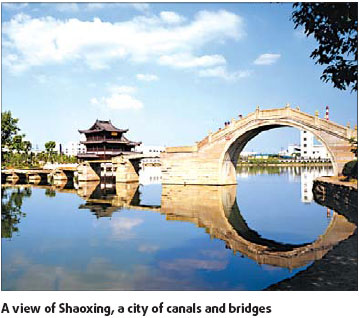History and cultural brilliance shine in Yangtze River Delta

Among the first 24 national historic cultural cities to be listed by the State Council in 1982, Shaoxing, in East China's Zhejiang Province, has a history of more than 4,000 years.
In 2070 BC, Yu the Great (Da Yu), founder of the Xia Dynasty, the first in Chinese history, began to form his army by gathering hundreds of warriors in Kuaiji Mountain of Shaoxing.
During the Spring and Autumn Period about 2,500 years ago, Shaoxing was the capital of the Yue Kingdom. The late Chairman Mao Zedong once described Shaoxing as the city of celebrities, in keeping with the Chinese saying that goes: "A fair place tends to produce outstanding people."
Shaoxing has nurtured a great number of renowned figures like Yu the Great, King Gou Jian of the Yue Kingdom, painters Xu Wei, Zhao Zhiqian and Ren Bonian, educators and revolutionists Cai Yuanpei, Lu Xun, Qiu Jin, Xu Xilin, Tao Chengzhang and Zhou Enlai, and scientists Ma Yinchu and Zhu Kezhen.
Situated in the south corner of the Yangtze River delta, Shaoxing has the Qiantang and Chao'e rivers flowing through it, creating a riverside landscape that is the pride of southern China.
The famous scenic spots in Shaoxing integrate a 4,000-year-old history and civilization with classic architecture and the landscape of a typical southern Chinese riverside town.
The city's wealth of beautiful landscapes and cultural relic sites include the Kuaiji Mountain, the Mausoleum of Yu the Great, the former residence of Lu Xun, the ancestral residence of Zhou Enlai, the East Lake, the Orchid Pavilion, the Keyan Scenic Spot, the Great Buddhist Temple, the Zhuji Five Waterfalls, the ancient track road and the Shen Family Garden, all of which draw millions of visitors each year.
Shaoxing has been long renowned for being the town of canals, bridges, yellow wine and orchids.
Gu Kaizhi, a great painter of the Jin Dynasty (1115-1234), described the landscape of Shaoxing, with its mountains and rivers, in a poem: "Hundreds of peaks vie for beauty while thousands of rivers race for speed. Green trees shadow the mountains as rosy clouds rise."
Shaoxing has a rich cultural life with many kinds of local operas, including the immensely popular Yueju and Shaoxing operas.
The city is the birthplace of the Yueju Opera, and the China Yueju Opera Art Festival is held there annually.
Compared to the 600-year-old Kunqu Opera, the century-old Yueju Opera is considered a younger member of the Chinese opera family. Again, while grandeur and nobility are the hallmarks of the Peking Opera, the virtually all-woman Yueju Opera is characterized by its romanticism and subtlety.
With annual rainfall of 1,300 mm, Shaoxing has a humid monsoon climate, which yields typical southern Chinese crops and farm products.
Famous local products include Shaoxing sugariness rice wine, Pingshui gunpowder tea, Longjing tea, baked rice cake, fermented bean curd and aniseed flavored bean. The city is also known for its freshwater fish, sheldrake, Shaoxing orchid, waxberry, sweet orange and crystal bayberry.
Local handicrafts that have won national fame include celadon from Yue kiln, Shengzhou bamboo handcraft, Kuaiji Yue ink stone and Shaoxing black terai.
(China Daily 09/07/2007 page45)














